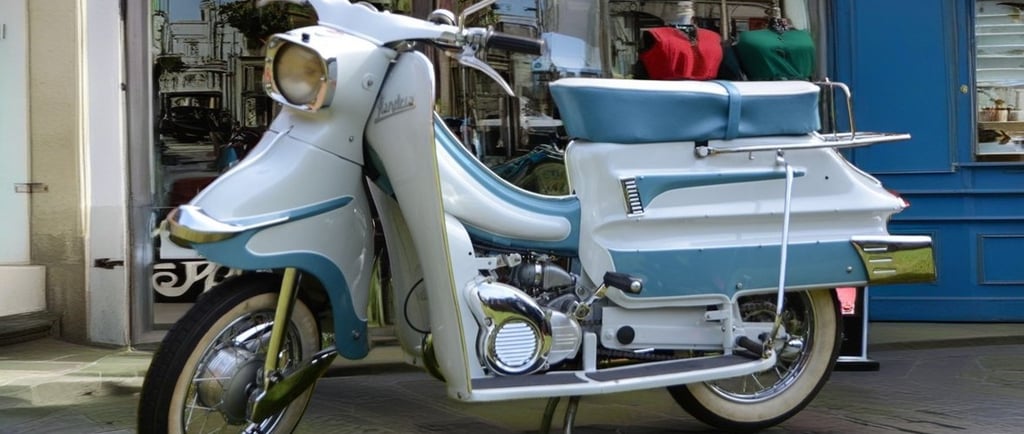Rediscovering the 1962 Flandria Parisienne Moped: A Vintage Treasure
This article explores the history, design, and cultural impact of the 1962 Flandria Parisienne moped, emphasizing its uniqueness and appeal among vintage moped enthusiasts.
BELGIUM TWO STROKEVINTAGE MOPEDSFLANDRIA1960'S
5/3/20243 min read


Rediscovering the 1962 Flandria Parisienne Moped: A Vintage Treasure
Introduction
The allure of vintage mopeds extends far beyond their functionality; these two-wheeled treasures encapsulate a bygone era of design, engineering, and youthful adventure. Among these nostalgic machines, the Flandria Parisienne shines as a remarkable specimen. Crafted in 1962, this Belgian-made moped is a testament to Flandria's commitment to innovation and quality. With its distinct aesthetic and mechanical prowess, the Parisienne invites enthusiasts and collectors alike to delve into its storied past, uncovering the rich tapestry of history and craftsmanship that defines the vintage moped culture.
History of Flandria
The Flandria brand, born in the heart of Belgium, stands as a beacon in the history of two-wheeled transportation. From its inception, Flandria carved a niche for itself as a manufacturer of bicycles, mopeds, and motorcycles that exemplified European craftsmanship. The 1960s marked a golden era for the company, drawing acclaim across Europe and beyond for its durable and elegantly designed products.
Among the iconic models that Flandria introduced, the Parisienne is particularly noteworthy. Launched in the early 1960s, this model embodied the spirit of adventure and freedom that was synonymous with the era. It was a period of significant growth and innovation for Flandria, with the Parisienne emerging as a symbol of the brand's dedication to quality and performance. Rooted in a family business that spanned generations, Flandria's legacy is a story of persistence, invention, and a passion for pushing the boundaries of moped design.
Design and Features of the 1962 Model
The 1962 Flandria Parisienne stands out not just for its age, but for its distinctive design that marries form and function in a compact, eye-catching package. Resembling a mix between a traditional scooter and a moped, it features small, nimble tires akin to those found on scooters of the time, but maintains the lightweight and versatile frame of a moped. This unique combination made the Parisienne particularly appealing to a wide range of riders.
At its heart, the Parisienne was powered by a 50cc engine, modest yet efficient for city commuting and light travel. Notably, the moped was equipped with four gears and forced ventilation, a rare feature that hints at Flandria’s forward-thinking design ethos. Despite the era’s limited technology, the Parisienne promised a reliable and enjoyable ride, thanks to its hardy build and the meticulous overhauling process each unit underwent. The lack of front and rear lights glass and a non-turning engine in some units underscored the model’s need for restoration, revealing a moped ripe for revival by enthusiasts of vintage machinery.
The Parisienne's Impact and Legacy
The Flandria Parisienne not only stood as a testament to the engineering prowess of its creators but also left a lasting impact on the moped culture. Its inception into the market added a layer of sophistication and versatility to the moped scene, appealing to a demographic keen on blending the practical utility of mopeds with the adventurous spirit of off-road scooters.
Today, the Parisienne is celebrated for its rarity and the unique niche it occupies among vintage moped collections. Finding a Parisienne in good condition is a treasure hunt, with enthusiasts eager to restore and preserve these machines for future generations. The stories and memories attached to these mopeds enrich the fabric of vintage moped culture, making each Parisienne more than just a vehicle, but a piece of history. Its legacy endures in the hands of collectors and enthusiasts who cherish the blend of utility, beauty, and adventure it represents.
Conclusion
As we traverse the lanes of motorcycle history, the 1962 Flandria Parisienne moped emerges as a vibrant thread in the tapestry of vintage culture. It exemplifies the spirit of an era that pushed the boundaries of design and mobility, offering a window into the past where innovation and adventure walked hand in hand. For collectors and enthusiasts, the Parisienne is not merely a moped; it is a symbol of heritage, a piece of art that continues to inspire a sense of freedom and nostalgia. As such, the legacy of the Parisienne rides on, a testament to the timeless appeal of vintage machines and the stories they carry with them through the ages.
